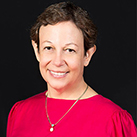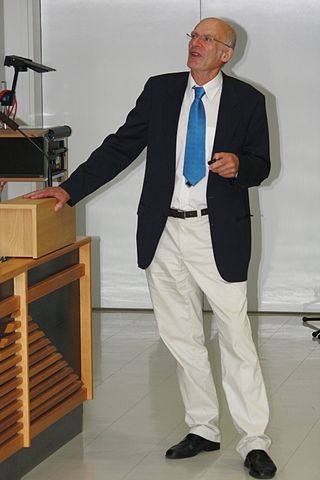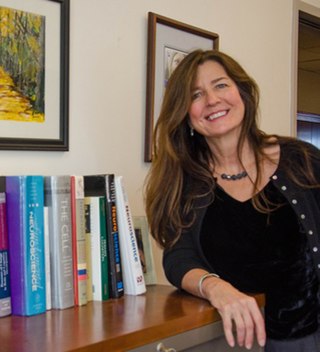
Echolocation, also called bio sonar, is a biological active sonar used by several animal groups, both in the air and underwater. Echolocating animals emit calls and listen to the echoes of those calls that return from various objects near them. They use these echoes to locate and identify the objects. Echolocation is used for navigation, foraging, and hunting prey.

Microbats constitute the suborder Microchiroptera within the order Chiroptera (bats). Bats have long been differentiated into Megachiroptera (megabats) and Microchiroptera, based on their size, the use of echolocation by the Microchiroptera and other features; molecular evidence suggests a somewhat different subdivision, as the microbats have been shown to be a paraphyletic group.

Forkhead box protein P2 (FOXP2) is a protein that, in humans, is encoded by the FOXP2 gene. FOXP2 is a member of the forkhead box family of transcription factors, proteins that regulate gene expression by binding to DNA. It is expressed in the brain, heart, lungs and digestive system.
Human echolocation is the ability of humans to detect objects in their environment by sensing echoes from those objects, by actively creating sounds: for example, by tapping their canes, lightly stomping their foot, snapping their fingers, or making clicking noises with their mouths. People trained to orient by echolocation can interpret the sound waves reflected by nearby objects, accurately identifying their location and size.
The language module or language faculty is a hypothetical structure in the human brain which is thought to contain innate capacities for language, originally posited by Noam Chomsky. There is ongoing research into brain modularity in the fields of cognitive science and neuroscience, although the current idea is much weaker than what was proposed by Chomsky and Jerry Fodor in the 1980s. In today's terminology, 'modularity' refers to specialisation: language processing is specialised in the brain to the extent that it occurs partially in different areas than other types of information processing such as visual input. The current view is, then, that language is neither compartmentalised nor based on general principles of processing. It is modular to the extent that it constitutes a specific cognitive skill or area in cognition.

The tragus is a small pointed eminence of the external ear, situated in front of the concha, and projecting backward over the meatus. It also is the name of hair growing at the entrance of the ear. Its name comes from the Ancient Greek tragos, meaning 'goat', and is descriptive of its general covering on its under surface with a tuft of hair, resembling a goat's beard. The nearby antitragus projects forwards and upwards.
Social neuroscience is an interdisciplinary field devoted to understanding the relationship between social experiences and biological systems. Humans are fundamentally a social species, and studies indicate that various social influences, including life events, poverty, unemployment and loneliness can influence health related biomarkers. Still a young field, social neuroscience is closely related to personality neuroscience, affective neuroscience and cognitive neuroscience, focusing on how the brain mediates social interactions. The biological underpinnings of social cognition are investigated in social cognitive neuroscience.
Music psychology, or the psychology of music, may be regarded as a branch of both psychology and musicology. It aims to explain and understand musical behaviour and experience, including the processes through which music is perceived, created, responded to, and incorporated into everyday life. Modern music psychology is primarily empirical; its knowledge tends to advance on the basis of interpretations of data collected by systematic observation of and interaction with human participants. Music psychology is a field of research with practical relevance for many areas, including music performance, composition, education, criticism, and therapy, as well as investigations of human attitude, skill, performance, intelligence, creativity, and social behavior.

Adele Dorothy Diamond is a professor of neuroscience at the University of British Columbia, where she is currently a Tier 1 Canada Research Chair in Developmental Cognitive Neuroscience. One of the pioneers in the field of developmental cognitive neuroscience, Diamond researches how executive functions are affected by biological and environmental factors, especially in children. Her discoveries have improved treatment for disorders such as phenylketonuria and attention-deficit hyperactivity disorder, and they have impacted early education.

Risto Kalervo Näätänen was a Finnish psychological scientist, pioneer in the field of cognitive neuroscience, and known worldwide as one of the discoverers of the electrophysiological mismatch negativity. He was a much-cited social scientist and one of the few individuals appointed permanent Academy Professor of the Academy of Finland. He retired in 2007 and retained a title of Academy Professor emeritus of the Academy of Finland. He was a professor at the University of Tartu starting in 2007.

Onychonycteris is the more primitive of the three oldest bats known from complete skeletons, having lived in the area that is current day Wyoming during the Eocene period, 52.5 million years ago.
James A. Simmons is a pioneer in the field of biosonar. His research includes behavioral and neurophysiological studies of sound processing in the echolocating bat. From the time he began graduate research in the late 1960s to the present, he has been in the forefront of bat echolocation research. Simmons was honored as a fellow of the Acoustical Society of America (ASA) in 1996 and of the American Association for the Advancement of Science in 2000. He was awarded the ASA's second Silver Medal in Animal Bioacoustics in 2005. His current position is Professor in the Department of Neuroscience, Brown University.
Ultrasound avoidance is an escape or avoidance reflex displayed by certain animal species that are preyed upon by echolocating predators. Ultrasound avoidance is known for several groups of insects that have independently evolved mechanisms for ultrasonic hearing. Insects have evolved a variety of ultrasound-sensitive ears based upon a vibrating tympanic membrane tuned to sense the bat's echolocating calls. The ultrasonic hearing is coupled to a motor response that causes evasion of the bat during flight.
Echolocation systems of animals, like human radar systems, are susceptible to interference known as echolocation jamming or sonar jamming. Jamming occurs when non-target sounds interfere with target echoes. Jamming can be purposeful or inadvertent, and can be caused by the echolocation system itself, other echolocating animals, prey, or humans. Echolocating animals have evolved to minimize jamming, however; echolocation avoidance behaviors are not always successful.
April A. Benasich is an American neuroscientist. She is the Elizabeth H. Solomon Professor of Developmental Cognitive Neuroscience, director of the Infancy Studies Laboratory at the Center for Molecular and Behavioral Neuroscience, and director of the Carter Center for Neurocognitive Research and Professor of Neuroscience at Rutgers University. She is also a principal investigator within the National Science Foundation-funded Temporal Dynamics of Learning Center headquartered at the University of California, San Diego’s Institute for Neural Computation.

Russell "Russ" Alan Poldrack is an American psychologist and neuroscientist. He is a professor of psychology at Stanford University, associate director of Stanford Data Science, member of the Stanford Neuroscience Institute and director of the Stanford Center for Reproducible Neuroscience and the SDS Center for Open and Reproducible Science.

Stephen Andrew Maren is an American behavioral neuroscientist investigating the brain mechanisms of emotional memory, particularly the role context plays in the behavioral expression of fear. He has discovered brain circuits regulating context-dependent memory, including mapping functional connections between the hippocampus, prefrontal cortex, and amygdala that are involved in the expression and extinction of learned fear responses.

Betty Jo "BJ" Casey is an American cognitive neuroscientist and expert on adolescent brain development and self control. She is the Christina L. Williams Professor of Neuroscience at Barnard College of Columbia University where she directs the Fundamentals of the Adolescent Brain (FAB) Lab and is an Affiliated Professor of the Justice Collaboratory at Yale Law School, Yale University.
Caroline Palmer is the Canada Research Chair in Cognitive Neuroscience of Performance and Professor in the Department of Psychology at McGill University in Montreal, Canada. She is also an Associate Faculty Member in the Schulich School of Music at McGill. Her research in cognitive science addresses the behavioural and neural foundations that make it possible for people to produce auditory sequences such as playing a musical instrument or speaking. Palmer has developed and empirically tested computational models of how people perceive and produce auditory sequences, and how they coordinate their actions with others.
Annemarie Surlykke was a Danish physiologist. She contributed significantly to bioacoustic research, in particular in the fields of insect hearing and acoustic communication, bat echolocation and insect-bat interactions. Graduated from University of Southern Denmark, employments at University of Tübingen and Aarhus University. From 1987 associate professor at University of Southern Denmark, full professor in 2011.










